
How to Safely Run Low-Voltage Lighting Through Your Lawn
Introduction
Installing low-voltage lighting in your lawn can add beauty and functionality to your outdoor space. However, it's important to plan the installation carefully to avoid safety hazards. In this article, I will walk through the key steps and considerations for safely running low-voltage lighting through your lawn.
Determine the Lighting Layout
The first step is deciding where you want to place the low-voltage lights. Common options include:
- Accenting trees, shrubs, or garden beds
- Lining pathways and driveways
- Providing security lighting around the perimeter of your property
Sketch out a lighting plan to visualize the layout. Factor in any existing structures, plants, or utilities to avoid conflicts.
Select the Right Low-Voltage Lighting Components
Low-voltage lighting systems typically operate on 12 or 24 volts, making them safer than the 120-volts used for standard electrical wiring. Key components include:
-
Low-voltage transformers - Converts 120V household current into 12V or 24V for the lighting. Select a transformer with enough wattage for your number of lights.
-
Low-voltage lights - LED or halogen lights designed for 12V or 24V operation. Choose lights suited for outdoor use that match your desired brightness and color temperature.
-
Low-voltage wires - Typically 16 or 18 gauge, 2-conductor wires that connect your lights to the transformer. Outdoor-rated cables work best.
-
Connectors and splitters - Allow you to link multiple lights to one cable. Use waterproof gel-filled connectors.
Bury the Wiring
Burying the low-voltage wiring protects it and provides a clean, seamless look. Here are some tips:
-
Use underground-rated direct burial cable that is waterproof and safe for underground installation.
-
Bury the cable at least 6 inches deep to avoid damage from aerators or other lawn tools. Consider burying at 12 inches for extra protection.
-
Lay the wire in gentle swoops instead of straight lines to allow slack in the cable if the ground shifts.
-
Avoid buried utilities like irrigation lines or electrical by calling 811 before you dig.
Connect the System Safely
Follow these safety tips when connecting your low-voltage lighting system:
-
Keep connections dry by making them in weatherproof junction boxes.
-
Use wire nuts or gel connectors rated for outdoor use to join wires.
-
Connect components to the transformer's low-voltage side only to avoid shock risk. Never connect anything to the incoming 120V side.
-
Install a GFCI outlet if using an outdoor receptacle for the transformer.
-
Turn off power at the breaker when installing or modifying connections.
Test the Lights and Enjoy
Once everything is securely connected, turn the lights on and test the system. Make any tweaks needed for full coverage. Then relax and enjoy your new landscape lighting! Proper planning and installation will keep your low-voltage lawn lights shining brightly and safely for years to come. Let me know if you have any other questions!